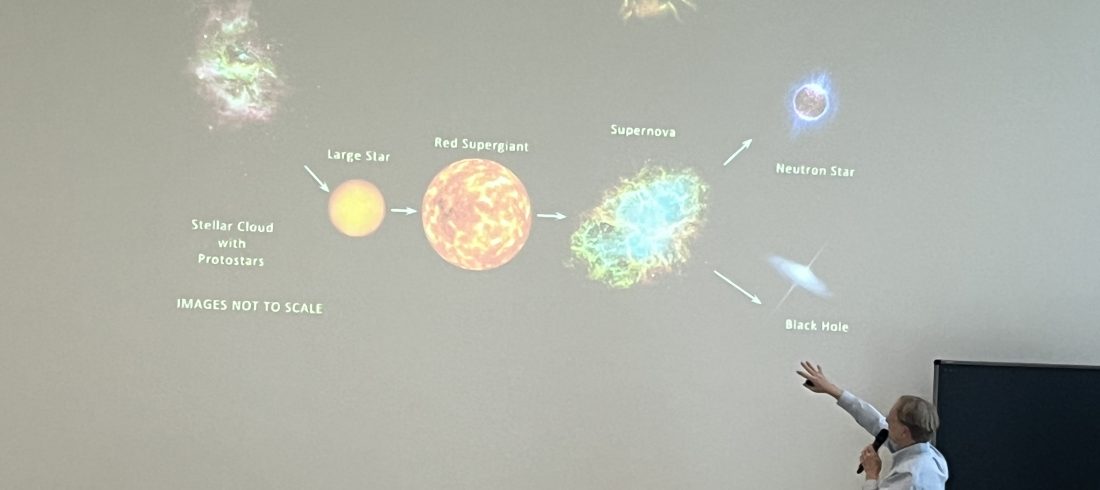
Autorin: Andrea Pöschl
For english version please scroll down!
Schwarze Löcher – vermutlich eines der mysteriösesten Objekte in unserem Universum. Theoretisch ist ihre Existenz im Jahr 1915, von Albert Einsteins Relativitätstheorie vorhergesagt worden. Für einen Beweis mussten jedoch noch mehrere Jahrzehnte vergehen. Bei unserem Workshop am 10.5. haben wir viel über Schwarze Löcher erfahren – Eigenschaften, Nachweise, historischen Kontext… – und am Ende durften wir selbst zu den MathematikerInnen werden und Berechnungen zum Thema Schwarze Löcher durchführen.
Im ersten Teil des Workshops, haben wir beim Vortrag von Peter Habison viele spannende Fakten erfahren. Beispielsweise, dass Schwarze Löcher nur durch 3 Eigenschaften beschreibbar sind – Masse, elektrische Ladung und Drehimpuls – so sagt es das „Keine Haare Theorem“ voraus. Durch eine Animation konnten wir den Weg von einfallenden Photonen auf ein Schwarzes Loch besser nachvollziehen. So haben wir von der Photonen Sphäre gehört – eine Region in den Photonen um das Schwarze Loch kreisen, ohne es jemals zu betreten. In diesem Zuge haben wir auch über verschiedene Gruppen von Schwarzen Löchern gesprochen, vorallem den Stellaren und den Supermassereichen Schwarzen Löchern. Der Unterschied? Die Masse. Da Stellare Schwarze Löcher nach dem Tod eines großen Sternes, einer sogenannten Supernova, entstehen, haben sie meist nur mehrere Sonnenmassen. Supermassereiche Schwarze Löcher hingegen haben mehrere Millionen bis Milliarden Sonnenmassen.
Das Supermassereiche Schwarze Loch Sagittarius A*, das Zentrum der Milchstraße, hat uns näher beschäftigt. Wie konnte dessen Existenz nachgewiesen werden? Die Antwort brachte Reinhard Genzel und Andrea Ghez im Jahr 2020 den Nobelpreis für Physik. Da Schwarze Löcher nicht direkt bewiesen werden können, musste auf ihre Umgebung geachtet werden – im Falle von Sagittarius A*, das S-Sternen Kluster. Der Stern S2 war dabei besonders interessant, da die Umlaufzeit nur 16 Jahre beträgt, konnte man in vergleichsmäßig kurzer Zeit den ganzen Orbit beobachten und damit dann auf das Objekt im Zentrum schließen.
Im zweiten Teil durften wir selbst aktiv werden. Jede Gruppe, bestehend aus ungefähr 5 Personen, sollten alle diesselben Rechnungen durchführen. Die Ergebnisse sollten wir nachher gut übersichtlich vortragen. Damit konnten wir lernen, wie man Berechnungen vorträgt, möglichst nachvollziehbar und möglichst wissenschaftlich. Viele von uns haben nur das Ergebnis vorgetragen, das große Problem dabei? Die Nachvollziehbarkeit. Ohne Rechenweg, gibt es keine Möglichkeit den Fehler zu finden. Alles in allem war es ein sehr spannender und lehrreicher Tag.
Über die Autorin:
Andrea Pöschl ist eine 18-jährige, gerade fertig mit der Matura und bereit für das Leben. Sie befasst sich gerne mit allen physikalischen Themen und sitzt manchmal auch stundenlang an der Nähmaschine.
Black Holes – one of the most mysterious objects in our universe. Theoretically their existence was predicted 1915, by Albert Einsteins Theory of Relativity. Evidence was brought tens of years later. During our Workshop on May 10th, we could lean much about Black Holes – proberties, Evidence, historical Context… – in the end we could become Mathematicians ourselves and did Calculations on the topic Black Holes.
In the first part of the Workshop, we learned several facts about Black Holes from Peter Habison. For example, that Black Holes can be described by only 3 characteristic properties – mass, electric charge and angular momentum – as the “No Hair Theorem” predicts. Via an animation, we could understand the path of infalling photons on a black hole better. In this context, we heard about the Photon Sphere – a region where photons orbit the Black Hole without ever entering it. Furthermore, we talked about the different types of black holes, especially about stellar and supermassive black holes. The difference? The mass. Because stellar black holes are created by the death of a giant star, a so-called supernova, their mass is around multiple solar masses. Supermassive black holes on the other hand have a mass of million to billion solar masses.
The supermassive black hole Saggitarrius A*, the centre of the milky way, concerned us further. How could it´s existence be proven? The answer to that question brought Reinhard Genzel and Andrea Ghez the Noble Price for Physics in the year 2020. Because Black holes can´t be proven directly, one must observe the environment of the black hole – in the case of Saggitarius A*, the S-Star Cluster. The Star S2 was especially interesting due to it´s short circulation time of only 16 years, so in relatively short time, the whole orbit of the star could be observed and with that data, the scientists could draw conclusions on the object in the center.
In the second part we could get active ourselves. Every group consisting of around 5 people should calculate the same calculations as the other groups. The results were afterwards presented. In that way we were able to learn how one makes a presentation as comprehensible and scientifically as possible. Many of us only presented the results, the big problem of that was the traceability. Without the calculating path, there is no possibility of finding the mistakes. All in all, it was a very interesting and educational day.
About the author:
Andrea Pöschl is an 18-year old, just finished her finals and is ready for life. She is interested in all Physics-related Topics and sometimes she spents hours on the sewing machine.